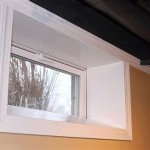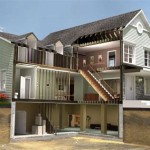Adding an Egress Window to Your Basement: Essential Factors
Installing an egress window in your basement is a crucial safety enhancement that can transform a confined space into a more livable and secure environment. Here are some essential aspects to consider when adding an egress window to your basement:
1. Code Requirements and Building Permits
Before embarking on your project, it's essential to consult local building codes and obtain necessary permits. Egress window installations are typically subject to specific sizing, placement, and safety standards. Ignoring code requirements can lead to fines and potential legal issues.
2. Basement Wall Thickness
The thickness of your basement walls will influence the scope of the excavation and installation process. Determine the thickness of your walls and ensure that the egress window frame and well are compatible. Proper excavation techniques and structural support are crucial to maintain the integrity of your basement.
3. Window Type and Size
The size and type of egress window you choose will depend on the layout and dimensions of your basement. The most common option is a casement window that opens outward, providing a clear escape route. Basement egress windows must meet specific minimum dimensions to allow for easy exit in an emergency. Consulting with a licensed contractor or architect can help you determine the optimal window size and type for your space.
4. Location and Placement
The location of your egress window is crucial for both safety and convenience. It should be easily accessible, preferably near a sleeping area. Ensure there are no obstructions (such as furniture or equipment) that could impede quick exit. The window should be placed high enough to meet code requirements and provide ample natural light and ventilation.
5. Egress Well and Ladder
An egress window is typically installed in an excavated well or pit to provide a means of escape at ground level. The well should be sized to allow for safe passage and should be covered with a removable grate or lid. A ladder must be installed within the well to facilitate a quick and safe exit.
6. Waterproofing and Drainage
When installing an egress window, it's essential to ensure proper waterproofing and drainage to prevent water seepage and potential basement flooding. Install a防水 membrane around the window frame and well to safeguard against moisture intrusion. Ensure that the well is graded properly to direct water away from the foundation and that there are no obstructions in the drain line.
7. Professional Installation
It's highly recommended to entrust the installation of an egress window to a licensed and experienced contractor. They possess the necessary skills and knowledge to ensure a safe, compliant, and durable installation. Improper installation can compromise the integrity of your basement and pose safety hazards.
Conclusion
Adding an egress window to your basement is an investment in safety and peace of mind. By considering these essential aspects and working with qualified professionals, you can create a safe and livable space that meets all necessary code requirements.

How To Install A Basement Egress Window Acculevel

How To Add An Egress Window Your Finished Basement

Pros And Cons Of Egress Windows News Events For Thrasher Foundation Repair

Smart Moves To Keep Your Basement Dry Tips And Tricks

Basement Egress Window Cost And Installing An

Installing Egress Windows Pros Cons Costs

Basement Egress Window Cost And Installing An

How Much Value Does An Egress Window Add Home Inspection Geeks

Adding An Egress Window To Basement Hometalk

Egress Window Installation Considerations To Prevent Leaking Budget Dry Waterproofing
See Also








